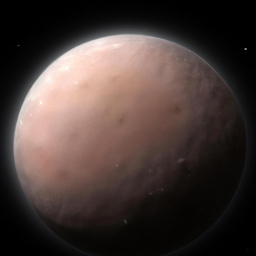Recent observations from the James Webb Space Telescope (JWST) have unveiled intriguing details about the dwarf planet Makemake, located in the outer reaches of our solar system. This celestial body, which is one of the largest known dwarf planets, has been found to be surrounded by a faint glow of methane gas. The discovery raises questions about the nature of this gaswhether it is part of a tenuous atmosphere or if it is being expelled into space, a phenomenon that has been colloquially referred to as the planet farting. In my experience studying celestial bodies, the presence of gases around such distant objects can provide significant insights into their composition and behavior. The JWST, equipped with advanced infrared technology, has the capability to detect these subtle emissions, allowing scientists to explore the characteristics of Makemake in greater detail than ever before. This observation is particularly noteworthy because it sheds light on the atmospheric conditions of dwarf planets, which are often overlooked in favor of larger planets in our solar system. Makemake, discovered in 2005, is part of the Kuiper Belt, a region filled with icy bodies and remnants from the early solar system. It is classified as a trans-Neptunian object and is known for its reddish color, which is attributed to the presence of tholinscomplex organic compounds formed by the interaction of ultraviolet light with methane and other gases. The recent findings regarding methane emissions add another layer of complexity to our understanding of this dwarf planet. Research confirms that methane is a significant component of the atmospheres of other celestial bodies, including Pluto. However, the situation with Makemake appears to be different. According to official reports from the JWST observations, the methane surrounding Makemake is not as dense as one might expect from a traditional atmosphere. Instead, the gas appears to be faintly glowing, suggesting that it may be escaping into space rather than being retained by gravitational forces. This phenomenon could indicate that Makemake has a very thin atmosphere, if it has one at all. Experts agree that the implications of this discovery are profound. The presence of methane could suggest that Makemake has geological activity or cryovolcanismprocesses that involve the eruption of icy materials instead of molten rock. Such activity could lead to the release of gases into the surrounding environment, contributing to the observed emissions. This aligns with the findings of other studies that have indicated the potential for geological activity on similar celestial bodies. The JWSTs ability to detect these faint emissions is a testament to its advanced technology and the importance of infrared observations in planetary science. The telescopes observations allow for a more nuanced understanding of the physical and chemical processes occurring on distant worlds. As observed in other studies, the ability to analyze the light emitted by gases can reveal their composition, temperature, and even the dynamics of their movement. Furthermore, the discovery of methane around Makemake raises questions about the potential for life in extreme environments. While the conditions on Makemake are not conducive to life as we know it, the presence of organic compounds like methane could indicate that the building blocks of life exist in various forms throughout the solar system. This aligns with the ongoing search for extraterrestrial life, which has expanded beyond traditional habitable zones to include environments that were previously considered inhospitable. The implications of this research extend beyond Makemake itself. As scientists continue to study the outer solar system, they may uncover more about the formation and evolution of celestial bodies in this region. The Kuiper Belt is thought to be a remnant of the early solar system, and understanding its constituents can provide insights into the processes that shaped our planetary neighborhood. In conclusion, the observations made by the James Webb Space Telescope regarding the faintly glowing methane surrounding Makemake open new avenues for exploration and understanding of dwarf planets. The potential for geological activity, the implications for the presence of organic compounds, and the insights into the early solar system all contribute to a richer understanding of our cosmic environment. As research continues, it is likely that we will uncover more about the mysteries of Makemake and its role in the broader context of planetary science. The JWSTs findings not only enhance our knowledge of this distant world but also underscore the importance of continued exploration and observation in unraveling the complexities of our universe.
James Webb telescope spies a 'farting' dwarf planet with fluorescent gas in the outer solar system

TRENDING NOW
WORLD
Global Messaging Trends: Can Local Apps Like Arattai Overtake Giants?
44% 🔥
POLITICS
Accusations fly over whether Republicans or Democrats 'own' shutdown
35% 🔥
POLITICS
Rep. Mike Haridopolos, R-Fla., talks about the government shutdown
34% 🔥
POLITICS
What happens now that the government has shut down. And, a pricing deal with Pfi...
26% 🔥
POLITICS
Married, but no connection: Reality of silent divorces in Indian homes
31% 🔥
POLITICS
Netanyahu's apology to Qatar, phone on Trump's lap: A telling White House photo
38% 🔥
MOST READ
SPORTS
Week 5 NFL odds, lines, betting picks, spreads: 2025 predictions: Model backs Sa...
55% 🔥
SPORTS
Predicting every undefeated college football team's first loss: Will anyone beat...
36% 🔥
SPORTS
Tigers Lefty Tarik Skubal Deserves Second Straight AL Cy Young Award
54% 🔥
SPORTS
Jets Get Official Braelon Allen Injury Diagnosis
61% 🔥
SPORTS
Gill: India won't be 'looking for any easy options' against West Indies
49% 🔥
SPORTS
Phil Mickelson takes a jibe at golf during friendly banter with ex-LIV Golf CEO’...
39% 🔥
